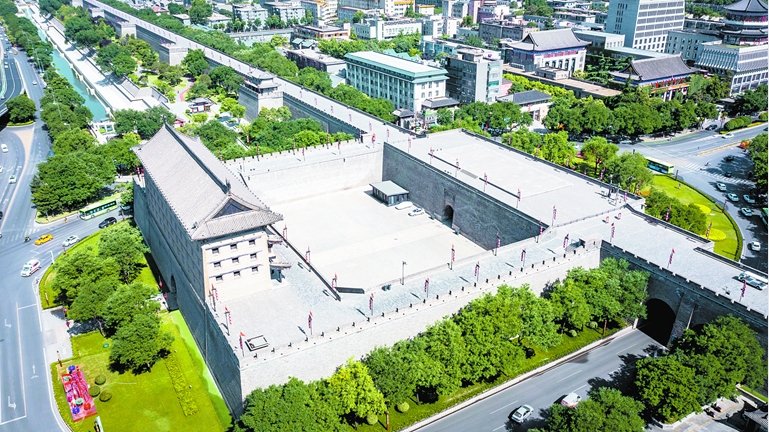Muography: Cosmic Rays Revolutionize Relic Investigations

The photo shows the Anyuan Gate (North Gate) of the Xi'an City Wall. (COURTESY PHOTO)
By Staff Reporters
Many cultural relics in China have stood for hundreds of years, and it is often difficult to detect the damage deep inside them. Now, however, through the adoption of muography, a research group from Lanzhou University (LZU) has managed to conduct a detailed and high-resolution survey on a rampart of a 600-year-old city wall in Xi'an, northwest China's Shaanxi province.
How muography tech works
According to the research group, muography is a rapidly developing and non-destructive tomographic technology that uses cosmic ray muons.
"Muon" is a type of subatomic particle which is generated when cosmic rays go through the Earth's atmosphere. Muons are similar to electrons, but the mass of a muon is 207 times the mass of an electron. It is estimated that 10,000 muons hit the sea surface per square meter every minute, said a researcher from the group.
Compared with neutrons, X -rays and gamma rays, muons have stronger penetrating capability. As muons go deeper inside an object, their energy decreases gradually. When the outline of an object is known, researchers could deduce the density and the inner structure of the object by detecting the intensity attenuation of muons inside the object.
"It's like the imaging of a human body by X-ray scanning," said Liu Juntao, member of the research group.
The researchers put muon detectors around the object, and collect the muon calculation data based on the penetration situations from different directions in the object. The data is then analyzed by computer to realize the 3D image of the object.
"If there is a one-meter wide hole in objects like city walls as thick as over ten meters or even dozens of meters, we could definitely detect it by muography," said Liu.
Challenge accepted
Situations in real life are much more complicated than in laboratories. The researchers encounter many challenges in the process of producing the 3D image of the city wall.
The equipment had to be put outside the room and endure the natural environment like wind and sun, said Yao Kaiqiang, postgraduate student at LZU. This led to many problems, for example, the signals received by the equipment could become unstable due to electrical short circuits or hugely fluctuating voltage. The research group updated the detector used in their lab to better cope with such situations, and Yao and another researcher stayed in Xi'an to check the equipment frequently and process the chaotic data gained in the unstable environment.
The data processing was also a challenge. One issue was the amount of data acquired was much smaller than that of unknown quantity to be solved. Liu Guorui, postgraduate student at LZU said that this required her and her coworkers to pick out the most reasonable model that could satisfy several equations at the same time.
In addition, calculations became difficult when there was density anomaly, as the result could be affected by systematic deviation, according to Liu Guorui. The calculation result showed that there was a hollow in the northern part of the rampart, but the researchers had to exclude technical reasons like improper measurement or data processing, before confirming the result.
Archaeological application
After the result was verified, it was found that there were indeed some apparent density anomalies inside the rampart.
Surprisingly, the result also identified an area of low density and clearly presented its location, shape and size. The area turned out to be the power distribution room, which researchers were not told about in advance. This is an effective verification of muography via blind testing.
Wu Chun, deputy director of the management committee of the Xi'an City Wall, hoped that further cooperation with the research group could prove that the technology is safer and more accurate, thus making it possible to have more forward planning in preventive conservation, by providing reliable references for repairing the wall with the assistance of geological surveys.
As early as November 2020, the research group developed China's first cosmic ray muons tomography system, with triangular bar plastic scintillator detectors. Now the system has been taken out of the lab and been applied in the field. The localization rate of this technology has reached 95 percent, according to Liu Juntao.
"This technology would definitely play a role in investigating large-scale archaeological sites," said Liu, adding that Dunhuang Academy is now communicating with the research group, planning for future cooperation in detecting the inner structures of the famous grottoes.







